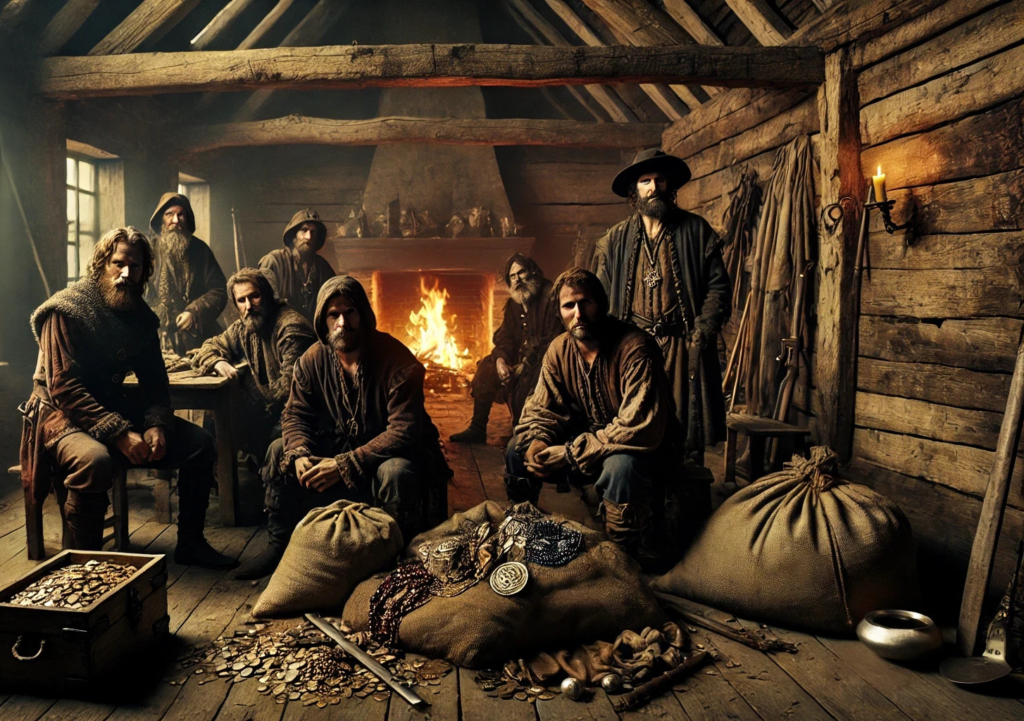In the previous post, we examinated the origins of this gruesome profession. Now let’s take a look at the social status of those who became executioners.
Once someone agreed to take on this role, he was installed in the executioner’s cottage, which until the 17th century was centrally located near the town hall. The cottage was not only the executioner’s home, but also the town’s prison. During the 17th century however, their lodgings were moved to the outskirts of the cities, probably to separate them from ”decent” people.
Although the executioner was a social outcast, he received housing, salary and clothing from the city. In addition to a fixed annual salary, he was also paid for the “chores” he performed. He could also in some cases keep the clothes of the executed, and executioners could therefore be quite well dressed.

Executioners also had a kind of official uniform. What this looked like is unknown, but it seems that red colored clothing was common. In Arboga, Sweden, the executioner is said to have been dressed entirely in red. In Gothenburg, his clothes were in red and yellow.
The executioner is sometimes said to have worn a mask or hood when performing his job, to preserve his anonymity. Which of course is contradicted by the fact that the executioner was branded so that everyone could very well see who he was.
The executioner had other duties, such as keeping the streets clean, killing and castrating animals, sweeping chimneys and emptying latrines – in short, tasks that other people did not want to do. He had a servant to help him with these chores, and with the executions and punishments, called a ”rackare”.
The executioners and rackare was, as one might expect, not very popular. One reason was of course their professions, that they killed and harmed people. But there was also a lot of superstitions surrounding their different chores that made them ”dirty”. And that dirt could contaminate anyone who came in contact with them.

This took many forms. For example, people avoided physical contact with executioners, and with their family members. It was rarely anyone who wanted to become their children’s Godparents and carry them at the baptism, for example. It was equally difficult to find witnesses when they were to marry. In some cases, the city simply had to step in and force people to take these roles.
There is even a story from Uppsala in 1665 where no one would step up to be Godparents to the executioner’s child. So the magistrate asked a vagrant, since he had such low status as well. He refused however, claiming he would rather be beheaded (he got to keep his head, but he was banished).
When an executioner would take communion, the priest turned the wine cup upside down, so that the executioner had to drink from the foot. That way, no decent person would have to touch the same part of the cup. In some areas, executioners weren’t even allowed to get married in a church.
Despite the social stigma around their occupation, the executioners were not completely isolated. Since they were condemned criminals, many of them seems to have continued their criminal activities, and the executioners cottage became a gathering place of criminals in some cities, and stolen gods were kept there.

In some cases, the executioner became almost like a gang leader, running or at least participating in organized crime. Such a case occurred in Stockholm at the end of the 1590s where the city’s executioner, Clemet Foss, led a gang that carried out thefts on a rarely seen scale. Clemet and his cronies had broken into almost every merchant’s stall and stolen enormous amounts of food, clothing, precious fabrics, firewood and luxury goods.
Another example is from Stockholm in 1618 where the city’s executioner, Master Håkan, had collaborated with the madam of a local brothel to blackmail the customers. While the men were occupied, Håkan had stolen their clothes, and they had been forced to pay a hefty price to get them back.
In these instances, the executioners were not punished. Maybe their occupation did protect them somewhat, since it seems to have been hard to acquire a new executioner. However, for many centuries, all of them would eventually be executed themselves by their successor.
But in the mid-17th century, something happened that would change the entire profession of executioners…
Sources:
Ambrius, Jonny. Att dömas till döden. Tortyr, kroppsstraff och avrättningar genom historien. (1996)
Sandén, Annika. Bödlar – liv, död och skam i svenskt 1600-tal. (2017)

